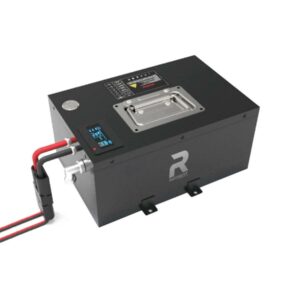Why do lithium batteries get worse over time?
Lithium batteries degrade over time due to electrochemical wear mechanisms like solid-electrolyte interphase (SEI) growth, lithium plating, and cathode material cracking. These processes reduce usable lithium ions, increase internal resistance, and lower capacity. High temperatures, deep discharges, and fast charging accelerate degradation. For instance, a battery cycled daily at 45°C may lose 30% capacity in 500 cycles versus 1,200 cycles at 25°C. Proper charging (20-80% SoC) and thermal management slow aging.
How to Maximize Forklift Battery Lifespan
What causes irreversible capacity loss in lithium batteries?
Capacity fade stems from lithium inventory loss and active material degradation. SEI layer growth on anodes permanently traps lithium ions, while cathode oxidation (e.g., NMC delithiation) reduces charge storage sites. Electrolyte decomposition at high voltages (>4.2V/cell) further depletes ion mobility. Pro Tip: Store batteries at 50% SoC in 15-25°C environments to minimize parasitic reactions.

Every charge cycle slightly thickens the SEI layer—like plaque buildup in arteries restricting blood flow. Lithium plating during fast charging or sub-zero operation creates metallic dendrites that pierce separators, causing micro-shorts. A 18650 cell cycled at 1C loses 20% more capacity over 800 cycles versus 0.5C charging. Transitional phrase: Beyond chemistry, mechanical stress matters—cathode particles fracture during expansion/contraction, disconnecting from conductive networks. Pro Tip: Use adaptive charging that slows rate above 80% SoC to reduce plating risks.
| Degradation Factor | Effect on Capacity | Mitigation Strategy |
|---|---|---|
| SEI Growth | -15% after 500 cycles | Limit full charges |
| Lithium Plating | -25% if frequent >1C charging | Use temperature-controlled charging |
| Cathode Cracking | -10% in high-DoD use | Partial discharges (20-80%) |
How does temperature accelerate battery aging?
High temperatures turbocharge degradation—every 10°C above 25°C doubles SEI growth rates. At 45°C, electrolyte oxidation produces CO2 gas that swells cells, while lithium plating risks spike below 0°C. Pro Tip: Never charge frozen batteries; warm to 10°C+ first to avoid catastrophic plating.
Imagine a car engine running non-stop at redline—that’s a battery at 45°C. Heat breaks down LiPF6 electrolyte into HF acid, corroding cathode structures. A 4.35V NMC cell loses 40% capacity in 200 cycles at 60°C versus 1,000 cycles at 25°C. Transitional phrase: Practically speaking, EVs in Phoenix suffer 2x faster range loss than those in Oslo. Warning:
Why do fast charging and deep discharges harm batteries?
Fast charging forces ions through anode graphite rapidly, causing bottlenecks that deposit lithium metal instead of intercalating. Deep discharges (0% SoC) strain cathode lattices—LiCoO2 cathodes lose oxygen atoms below 2.5V, permanently reducing capacity. Pro Tip: Set device charge limits to 85% and recharge at 20% SoC.
It’s like slamming a car’s brakes versus gentle stops—high-current charging creates localized hot spots. A study showed 3C charging degrades NCA cells 3x faster than 1C. Transitional phrase: But what if you occasionally need fast charging? Modern BMS units mitigate damage by preheating packs to 25-35°C, optimizing ion mobility. Real-world example: Tesla’s 250kW Supercharger only maintains peak rate until 50% SoC, then tapers to prevent plating.
| Charging Rate | Cycle Life (80% Cap.) | Plating Risk |
|---|---|---|
| 0.5C | 1,500 cycles | Low |
| 1C | 1,200 cycles | Moderate |
| 2C | 800 cycles | High |
Can battery management systems (BMS) slow degradation?
Advanced BMS algorithms combat aging via cell balancing, temperature regulation, and charge curve optimization. Multi-layer voltage monitoring (±2mV accuracy) prevents over-discharge, while active cooling maintains 20-40°C operating range. Pro Tip: Choose batteries with ≥16-bit BMS for precise state-of-health tracking.
A BMS acts like a battery’s personal trainer—it enforces safe “exercise” limits. For example, Tesla’s BMS redistributes charge during idle periods to balance cell voltages, reducing SEI growth gradients. Transitional phrase: Beyond hardware, software matters—adaptive charging in iOS/android learns usage patterns to complete charges just before unplugging, minimizing high-SoC stress. Real-world example: CATL’s self-healing BMS recovers 5% capacity by applying pulsed currents to dissolve minor lithium plating.
Do different lithium chemistries degrade at varying rates?
LFP (LiFePO4) batteries degrade 50% slower than NMC/NCA due to stable olivine structure resisting oxygen loss. However, they have lower energy density. NMC 811 loses 25% capacity in 1,000 cycles versus LFP’s 3,000+ cycles. Pro Tip: For solar storage, prioritize LFP—daily cycling with minimal capacity loss.
Think of LFP as marathon runners versus NMC’s sprinters. While NMC packs power EVs needing high energy density, LFP’s robust bonds withstand repeated charge cycles. A 100Ah LFP battery retains 80% capacity after 4,000 cycles at 25°C, whereas NMC hits 80% at 2,000 cycles. Transitional phrase: But there’s a trade-off—LFP’s 3.2V nominal voltage requires more cells for 72V systems, increasing BMS complexity.
Battery Expert Insight
FAQs
Can you reverse lithium battery degradation?
No—degradation is chemically irreversible. However, capacity “recovery” modes in some BMS units temporarily restore 2-5% by dissolving surface-level lithium plating.
Does wireless charging degrade batteries faster?
Yes—inductive charging generates 30% more heat than wired, accelerating SEI growth. Limit wireless use to intermittent top-ups, not full cycles.
How much does depth of discharge affect lifespan?
100% DoD cycles (0-100%) yield 500 cycles vs. 1,500+ at 50% DoD. Keep discharges above 20% for longevity.
